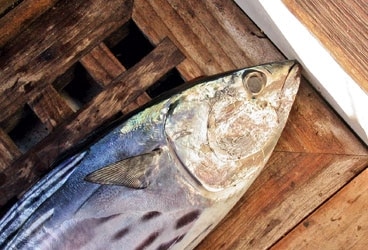
When my husband, Peter, and I set out to cruise in Mexico, we didn’t know that much about fishing. We had a vague idea that if we stood in the cockpit calling, “Here, fishy, fishy, fishy,” the dorado and tuna would leap eagerly out of the sea.
Strangely, this didn’t work. We made a few catches, but nothing you’d necessarily want to put on a plate: a 20-foot length of kelp, a small squid, and an extremely disgruntled seagull. We hooked a tuna once, but then we realized that we had absolutely no idea what to do with it. Someone had said something about a gaff and a bottle of rum, but we couldn’t remember the specifics, so we dropped the fish, gaffed the rum, and drank it down.
Eventually, our fishing skills improved. I remember looking on with satisfaction as our first catch, a silvery bonito, thrashed and flailed in our cockpit. After Peter dispatched it with a winch handle, I raised my fillet knife, salivating at the thought of the pale, buttery fish flesh I’d soon be peeling from the bone. I made my first incision.
Yuck! No one told me that bonito looks like liver!
Growing up in Northern California and shopping for fish in the market, I’d grown used to the idea that the world’s oceans teemed with salmon, trout, and fillet of sole, usually packed in white butcher paper with a small bag of ice to keep them fresh. That first bonito we caught, it turned out, had recently completed his breakfast, and his belly was distended with dozens of tiny bait fish. It was like a nautical version of Night of the Living Dead. I half expected them to come to life and start eating my brains.
If you put a bonito fillet next to a slab of steak, though, you’ll be hard-pressed to tell the difference. Their flesh is that red. And, as it turns out, that’s the trick to preparing these dark-fleshed fish: Just pretend it’s steak. Sear it, marinade it, or make a robust sauce for it, and you can’t go wrong. The bonito isn’t a nasty liver fish at all-it’s the filet mignon of the sea!
Spicy Mango bonito
- 2 tablespoons frying oil
- 1 fresh bonito, filleted (or 2 tuna fillets)
- 1 tablespoon toasted sesame oil
- 5 cloves garlic, minced
- 2 inches ginger, peeled and minced
- 1 tablespoon chili paste
- 1 onion, diced
- 1 red bell pepper, diced
- 1 tablespoon soy sauce
- 1/2 cup mango, orange, or pineapple juice
- 1/2 mango, cleaned and cut into chunks
- Juice from 1 lime
- 1 teaspoon cornstarch
- 1/4 cup water
- White rice, cooked
Heat a cast-iron skillet until smoking hot. Add frying oil, then sear fillets until cooked on the outside and rare in the center. Remove fish to a plate, covering with foil to keep warm. Wipe out skillet and allow to cool slightly before adding sesame oil. Over medium heat saute garlic, ginger, and chili paste in oil until hot and fragrant. Add onion and pepper. When vegetables are soft, add soy sauce and mango juice. Reduce heat and simmer.
Toss mango chunks in lime juice; set aside. Mix cornstarch with water and stir in slowly to sauce in skillet until thickened. Remove from heat. Adjust seasonings. Slice fillets crosswise with a sharp knife. Mound white rice on each plate and top with sauce. Lean slices of fish against the rice. Garnish with chunks of mango. Serves two.








